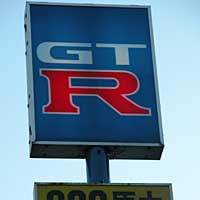With more power than an F1 Ferrari, Honda or McLaren, souped-up Nissan Skyline saloons have been the Japanese street racer's weapon of choice for decades. More recently, the sedate-looking Skyline's street cred has gone global, with Australia and Britain in particular reverberating to the roar of Japan's sedans gone mad. But what spread the white-knuckle word about these awesome four-wheeled beasts with four funny round lights on the back was not televised races, but a little box called the PlayStation.
Back in 1997, when Sony's PlayStation started stealing sales from Nintendo, the must-have racing game was "Gran Turismo," which not only featured groundbreaking computer graphics, but also an interesting premise that all players start with just 1,000,000 yen to buy a used car, tune it up, then take it racing to win their money back. The better the racer became, the more he or she won -- and the more they could spend making the car faster.
That was when gamers around the world learned what genuine Japanese hot-rodders had known for years: the cheapest and easiest way to make an 800hp street racer is to buy a used, late 1990s Skyline GT-R and upgrade the turbocharger. That way, you not only got yourself a four-wheel flying machine, but one with four-wheel drive and four-wheel steering, too -- helping racers both real and virtual to drive well beyond their abilities.
In 2001 Britain's Autocar magazine sent two champion gamers to Le Mans in a brand new GT-R to see how they'd fare on a real circuit in a real car. They spun off at the end of the Mulsanne Straight, earning Autocar an impressive repair bill. Game over.
This incident caused red faces in the gaming world, particularly because the GT-R is such an easy car to drive fast. Yes, acceleration is savage (0-100 kph in 4.9 secs; 0-100 mph in 12.3secs -- both faster than a Porsche Carrera 4) and the all-wheel steering and drive make it unbeatable through bends, except perhaps by a train. Entering a corner at speed, as soon as the GT-R's all-wheel drive sensors detect any loss of grip at the rear it starts to shift power to the front wheels, correcting a potential spin and allowing the driver to plow on through the corner oblivious. There really is no other feeling like it. Even Subaru and Mitsubishi rally cars lose grip earlier than a GT-R.
Last month, the BBC's celebrated motoring presenter Jeremy Clarkson mimicked Autocar's idea by trying to equal his PlayStation time at the controls of a virtual Honda NSX on the Laguna Seca raceway in California, using the real McCoy at the actual circuit. He couldn't get within 20 seconds of his game time, but no sooner had the program aired than his "Top Gear" show's Web site lit up as armchair racers opined that he'd have done much better in a GT-R.
But the Skyline story did not begin with the PlayStation. In fact the first car to bear that name was built by Fuji Precision Industries and marketed as the Prince Skyline from 1952 until 1966, when Nissan took over the fledgling car-maker. Though their Skylines were not particularly sporty, a GT version that Prince came out with in 1964 promptly took 2nd though 6th positions in the GT-II class at the second Japanese Grand Prix.
Clouds of burning rubber
No doubt aiming to build on those successes, the backroom boy racers at Nissan wasted no time in creating the first Skyline GT-R (Gran Turismo Racing), which hit the streets in clouds of burning rubber in February 1969. Popularly known as the "Hakosuka (Boxy Skyline)," this GT-R version of the squared-off four-door saloon boasted a 2-liter straight-six motor which knocked out more than 160hp -- as much as the Ferraris and Lamborghinis of the era.
Although their owners often stripped them of unnecessary trim and excess weight to improve racing performance, most GT-Rs never saw a real race track, but were instead raced illegally at night on the acres of concrete in dockland districts of Japan's port cities. Urban legend has it that the now-mainstream sport of drift racing first appeared at this time, when GT-R drivers used power slides to beat less powerful, but more nimble, Mazda RX-3s through tricky bends and intersections.
Realizing they were on to a good marketing thing for their brand, in 1971 Nissan replaced the Hakosuka with the "Kenmeri" GT-R, so nicknamed because the characters used in Skyline advertisements were an attractive Japanese couple of mixed decent called Ken and Mary. Although fewer than 200 of the second generation GT-Rs were sold over two years, largely due to their prohibitively high price tag, the car became the Nissan's flagship marque at home, just as the Z series made Datsun's name in North America.
Over the next 14 years, Nissan revamped the Skyline several times, making it progressively uglier with each incarnation. However, none of these sporty variations was badged as a GT-R, as they were not true racing cars, but mere GTs.
All that changed with the arrival of the R32 in 1988. The standard saloon had smooth, attractive lines, retained the traditional straight-six, 2-liter engine coupled to a rear-wheel drive format, and was available in 200hp turbocharged forms. Although the R32 GTS-t in particular quickly became a favorite with late-night drift racers, the best was yet to come.
With seemingly more of their daredevil spirit trouncing the constraints of corporate culture, those delinquent designers at Nissan saw fit to drop a bored-out 2.6-liter version of the engine into their next new version, affix not one, but two ceramic turbochargers, borrow Subaru's rally-bred four-wheel-drive system from Fuji Heavy Industries -- and, to top off the heady cocktail, fit electronically controlled four-wheel steering that actually worked.
The GT-R was back and a new legend was born.
During development, Nissan engineers took an R32 GT-R to Germany's Nurburgring circuit -- and smashed the production car lap record by a whopping 25 seconds. In domestic GT racing, the GT-R reigned supreme for three years, unbeaten for 29 consecutive races. Such was the car's dominance of Australian stock-car racing, where it quickly came to be called "Godzilla," that organizers ordered it to be hamstrung. First they insisted that all GT-Rs had to use only low-boost turbos -- but still they kept winning. Next the organizers ordered that every R32 being raced should carry 160 kg of ballast -- but still they kept on winning. Finally, R32s were banned outright from races -- for being too fast.
Unsporting of the Aussie authorities? Well, maybe -- but maybe not. Although they produced just 280hp when they rolled out of the showroom, these almost domesticated beasts could fast be made feral by removing the factory-fitted 180 kph speed limiter and simply reprogramming the electronic engine-management system. Instantly, another 70-odd ponies appeared under the driver's right foot.
If that still wasn't sufficient to slake a speed-freak's thirst for thrills, then specialist shops such as 800 Bariki in the street-racing city of Yokohama could double, or even treble the engine's output in a matter of hours. As well, at the Super Autobacs accessory store in the port city's Minato Mirai district, there's not only a rolling road on which owners can test their cars, but a wall of fame displaying photos of recently tested racers and their results. The rankings are consistently topped by GT-Rs that knock out around 800hp -- slightly more than Michael Schumacher's F1 Ferrari.
Perhaps feeling it had pushed the envelope as far as it was polite to do, in 1993 Nissan released a more portly R33, followed finally five years later by the squarer, meaner-looking R34 -- just in time for Sony's Gran Tourismo 2 video game. But, alas, the GT-R's days were numbered again. Not only have stricter emission controls introduced in this century done no favors for thirsty twin-turbo motors, but pencil pushers at Nissan, and their new masters Renault, also noted that the company lost money on every GT-R sold.
As a result, the Skyline range was totally overhauled in 2002, fitted with new leaner-burning and non-turbocharged 2.5 liter or 3.5 liter V6 engines. So now, every version of the current Skyline range carries the GT acronym . . . but the GT-R is no more.
But all may not yet be lost: strangely shaped Skylines have been seen setting incredible lap times at the Nurburgring in recent months. That appetizing intelligence comes after a strange hiatus since the 2001 Tokyo Motor Show, when Nissan displayed a GT-R concept car -- and then conspicuously failed to mention a GT-R at the 2003 show. However, the newly resurgent company did display a practical looking model at the same event last October, and motoring magazines have been guessing ever since as to what Nissan is really up to.
What is for sure is that the new car will not be a Skyline, but a stand-alone model in its own right, though it is likely to share many components with its sibling, possibly including a development of the current 3.5-liter V6, probably bored out a little. With twin turbos (of course), that should be good for 450hp, which pundits expect to be harnessed to a new version of the all-wheel drive and all-wheel steer systems. Right now, though, no one outside of Nissan's Technical Center in Atsugi really knows.
But there's no doubt Godzilla is coming back, probably in 2008 and for about 7 million yen -- which will leave a lot of change from the cost of a slower Ferrari when you've tweaked to your heart's content.




















With your current subscription plan you can comment on stories. However, before writing your first comment, please create a display name in the Profile section of your subscriber account page.